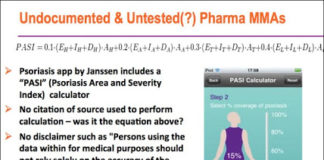After a day of cooking, I spent the remainder of the Thanksgiving Holiday weekend reading and highlighting sections of the 144-page brief that the Center for Digital Democracy (CDD) filed with the FTC on Thanksgiving eve (see “Center for Digital Democracy Challenges FTC to Reign In Online Pharma Marketing“).
This document — now in the public domain (find it here) — is perhaps one of the BEST reviews of healthcare-related digital marketing techniques that I have ever seen! I recommend that ALL pharma marketers read it to learn which companies to contact to help them do a better job reaching online consumers and physicians.
There were several companies and products mentioned that I have not heard of. In that regard, this brief — negative though it may be — is a promotional boon for these companies, IMHO. You can’t buy this kind of publicity and as a recent article in the New York Times proves, even negative publicity can help you get top listing in Google searches (see “A Bully Finds a Pulpit on the Web“).
I compiled a list of more than two dozen innovative online marketing products/solutions mentioned in the CDD brief. My list includes the product name, company/site name, description, link to online information, and the paragraph number in the brief where you can find what the CDD has to say about it (download the list here).
If your company is NOT listed, I suggest that you (1) contact CDD and ask them to amend their brief to include your solution and/or (2) file your own brief with the FTC.
Of course, CDD does not view these solutions as “innovative.” In fact the CDD thinks they are “unfair and deceptive”:
“The companies named in this complaint, as well as others involved in real-time tracking and bidding — including those that provide data optimization services for profiled targeting — are engaged in unfair and deceptive practices.”
I must admit that one or two of the services were a bit scary. QualityHealth’s “Focus on Formulary” solution, for example, claims to be “sophisticated technology” that “links consumer marketing with brand formulary access.” It designs “targeting messaging directly to millions of profiled consumers based on prescription coverage.” CDD says: “Few consumers likely realize, however, that they have consented to become the subjects of a ‘proprietary profiling technology’ that “captures… valuable information across over 100 individual data points,” including ‘consumers’ conditions and preferred treatments’; ‘doctor relationships and plans to visit the doctor’; and ‘insurance and formulary coverage.'”
ConditionMatch (offered by Good Health Media) claims to use “cutting edge behavioral targeting technology…[and] identifies groups with common sets of conditions/health-related characteristics by geographic region via insurance claims and individual ‘opt-in’ data.”
Both sound like they may have HIPAA privacy issues.
There is no lack of innovation regarding the names given to some of these solutions, such as:
- ActuatoRx Geo-Medical Targeting
- Acquire2Convert
- Healthographics
- Pluck
- Intent Targeting Advertising
- Target 2 Measure
- BuzzScape
- Social Operating System
- Bizo Targeting Platform
- Quantemo Engagement Index
- Subconscious Resonance Testing
- Evoked Response Potential
The CDD does not analyze whether or not the claims made by the companies it cites are credible or designed to hookwink gullible pharma marketers into purchasing their solutions. For example, are there any pharma marketers who are convinced that “Pluck,” which is designed to engage consumers in conversations with brands, is a viable solution for Rx products?
Which leads me to wonder why the CDD focused exclusively on healthcare marketing as a target for its critique. Many of the marketing tactics cited by CDD probably were first developed for the consumer goods industry and then renamed/rebranded to appeal to healthcare marketers as well. The CDD has helped accelerate the process!









![6 Digital Tools at the Center of Healthcare Digitalization [INFOGRAPHIC]](http://ec2-54-175-84-28.compute-1.amazonaws.com/pharma-mkting.com/wp-content/uploads/2021/04/6DigitalTools_600px-100x70.jpg)




